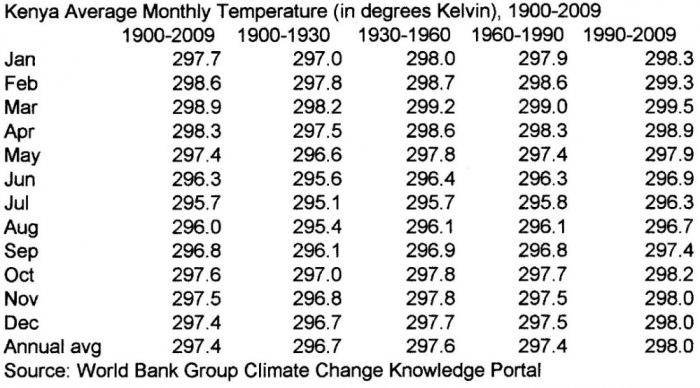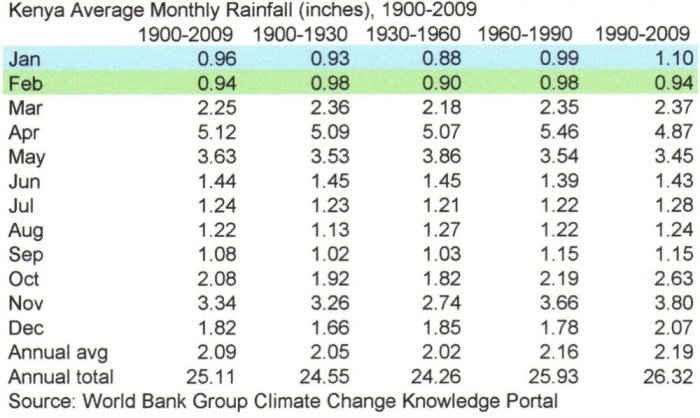Is Fighting Global Warming the Solution to Water Shortages in Kenya Or Elsewhere?

Late last year a group of evangelical environmentalists associated with the Office of Social Justice (OSJ) of the Christian Reformed Church, after returning from visiting Kenya, were featured in a series of videos titled "Climate Conversation: Kenya in which they say poor Kenyans are suffering from reduced rainfall caused by manmade global warming.
"It's unfortunate, but farmers all over Africa are talking about changing weather patterns," says Dr. Dennis Garrity, Director General, World Agroforestry Center, U.S.A. "There has been enormous changes in the onset of the rainy season, the length of the rains, the duration and the intensity of drought during the rainy season. And it all fits the scientific evidence that Africa is in fact the area of the world that is going to suffer the most from climate change."
Craig Sorley, Care of Creation Director for Kenya, explains, "Farmers in the past, when I was a young man, always say the rains were so predictable. And now the rains have become very unpredictable. They are playing a guessing game as to when the rains are going to arrive."
A native Kenyan farmer, Margaret, says, "It used to rain in January. But now the rain has changed. It doesn't come in January. Now it comes in February."
Sorley acknowledges that climate change isn't the only factor causing water shortages in Kenya. Deforestation is another. Because of it, he says, "a lot of the water that comes to our landscape flows very quickly off of that landscape and goes down into the ocean, and leaves behind a rather dry landscape. I think that's a combination of not only broader climate change across the globe but also as a result of the damage we have done to ourselves, to our landscapes."
"This issue of climate change can no longer be ignored," insists Kyle Meyaard-Schaap, OSJ Creation Care Coordinator, U.S.A. "I know it's divisive, I know that it's polarized, but that's not a good enough excuse. I can't look at the people that I talked to in this last ten days and tell them, 'Yes, but, this issue is polarized, this issue hurts people's feelings when you talk about it at home.' That's just not good enough for me anymore."
The implication is clear: To help the poor in Kenya (and other developing nations), we must fight global warming.
Yet the relevant climate facts in Kenya don't support these claims.
First, Kenya has not experienced a significant upward trend in average temperature, either monthly or annually, as the data in this table show.

The average annual temperature for 1990–2009 (the period when, supposedly, human activity had raised global temperature the most) was only 25 hundredths of 1 percent higher than the average for 1900–1990, an amount too small to have driven significant changes in Kenya's climate, including its rainfall.
Yet the videos did cite native Kenyans saying January rainfall had diminished over their lifetimes, and February rainfall had increased, making it more difficult for them to schedule planting.
But childhood memories are notoriously poor data sources, both for the past and for comparison with the present. Hard data are indispensable.
And the hard data in the table below show that, while rainfall amounts have risen and fallen in Kenya since 1900, there is no significant trend.
In 1990–2009, Kenya's average annual rainfall was 7.2% higher than in 1900–1930, 8.5% higher than in 1930–1960, 1.5% higher than in 1960–1990, and 5.7% higher than in 1900–1990. Thus, the United Nations Development Program concluded in its country profile for Kenya, "Observations of rainfall over Kenya since 1960 do not show statistically significant trends," and because annual amounts vary significantly more than those periodic averages, the same can be said for the entire 110-year period.
Contrary to the perceived memories reported in the videos, there was no reduction in rainfall in January or increase in February. The very opposite was true. Average January rainfall in 1990–2009 was 18.7% higher than in 1900–1930, 25.1% higher than in 1930–1960, 11.2% higher than in 1960–1990, and 18.1% higher than in 1900–1990. And average February rainfall in 1990–2009 was 4% lower than in 1900–1930, 4.4% higher than in 1930–1960, 4% lower than in 1960–1990, and 1.4% lower than in 1900–1990.

Yet though not driven by changes in rainfall amounts, both droughts and floods might have become more common in Kenya.
Why? Because, as climatologist Dr. David Legates explained in his chapter in A Call to Truth, Prudence, and Protection of the Poor 2015: The Case against Harmful Climate Policies Gets Stronger, as population grows, demand for water increases, not just for drinking but also for agriculture, industry, and other uses, resulting in more frequent and severe droughts—even with no change in rainfall. And as undeveloped land is converted to agriculture (Kenya's agricultural land increasing from about 252,000 to about 275,000 square kilometers from 1961–2011), demand for irrigation water grows, again resulting in more droughts—again even with no change in rainfall.
Conversely, as land becomes more paved or built up, and as it becomes deforested, it absorbs less rain, sending more runoff into streams, which then flood more frequently and severely—again, even with no change in rainfall. Both urban development and deforestation have occurred in Kenya.
Are poor Kenyans suffering from water shortages? Yes. Is that because of global warming—manmade or natural? No. Is fighting global warming the solution? No.
Despite its moderate annual rainfall totals (about 26 inches per year, similar to that of Kansas and Minnesota), Kenya is potentially a water-rich nation. It borders on Lake Victoria—the second-largest freshwater lake in the world by area and ninth-largest continental lake by volume.
Most of Kenya, including its driest part, the Great Rift Valley, is within 200 miles of Lake Victoria, a distance readily served by aqueducts.
For comparison, the Roman aqueducts, built two millennia ago, carried water 260 miles, and the system of aqueducts constituting the California State Water Project (SWP) provides drinking water for over 23 million people (roughly half the entire population of Kenya) by transporting water hundreds of miles from the Colorado River, the Sierra Nevada, and central and northern California. The shortest, the Colorado River Aqueduct, is over 240 miles long.
Of course, California is wealthy (though it wasn't nearly so wealthy when much of the SWP was built), and Kenya is poor. How can Kenya afford to build such aqueducts—even if they would cover far less distance and serve only a small fraction of the people?
The real solution to Kenya's water needs is economic growth that will enable Kenyans to bear the costs of improved water transportation, storage, purification, and conservation through efficient use.
Sad to say, however, if climate change activists succeed in enacting policies to fight global warming, Kenya's economic growth will be curtailed.
Why? Because abundant, reliable, affordable energy is an essential condition of economic growth, and activists seek to fight global warming by shunning the use of the most reliable and affordable energy sources for the developing world—coal and natural gas—and putting far more expensive "Green" energy sources like wind and solar in their place.
As it happens, Kenya has an estimated 400 million tons of coal reserves and is about to begin mining them, making the coal available to generate electricity and deliver its people from the smoke that comes from burning wood and dried dung as primary cooking and heating fuels—smoke that causes high rates of illness and premature death, especially among women and children, from respiratory diseases.
In 2013, two other evangelicals made almost identical claims about climate change in Malawi. As I demonstrated then, those claims were false and based on the same kinds of mistakes shown in these videos.
I commend the good motives and lofty goals of those who make these claims. But motives and goals aren't enough. Accurate facts are essential to wise decisions.
Ironically, and sadly, the climate policy the makers of these videos want will only bring further harm to the very people they long to help, by prolonging their poverty—the real threat to Kenyans' health and life.




























